Adapting Hospitality: The Transformative Role of Hotels in Crisis Management
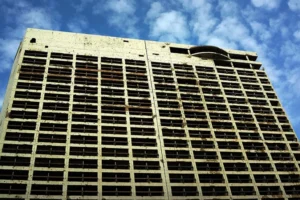
The image depicts the battle-scarred remnants of the former Holiday Inn in Beirut, Lebanon, captured by photographer Spencer Platt/Getty Images.
Hotels, typically synonymous with joy, comfort, and opulence—playing host to weddings, celebrations, and vacations, or facilitating more routine endeavors like business trips and conferences—found themselves in an unprecedented scenario amidst the ongoing COVID-19 crisis. As the pandemic progressively crippled the global tourism sector, vacant hotels were being repurposed into accommodations for essential medical personnel, quarantine facilities, or makeshift hospitals. No longer mere hubs of leisure and business, these establishments were swiftly transformed into indispensable components of crisis management infrastructure. This transformation echoes historical instances where hotels assumed critical roles during wartime, serving as strategic military outposts or media headquarters.
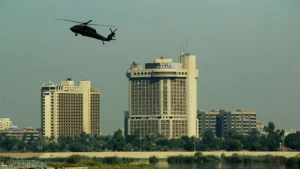
In the photo taken by Chris Hondros/Getty Images, a Blackhawk helicopter can be seen flying in the vicinity of the Sheraton and Palestine hotels in Baghdad, Iraq, on November 24, 2003. This image captures a moment fraught with tension, as it recalls the tragic incident on April 8, 2003, when two journalists lost their lives due to an American tank firing a shell at the Palestine hotel, which served as lodging for numerous journalists at the time.
Examples abound, such as the iconic hotels in Beirut during the “Battle of the Hotels” in 1975, where they became strategic assets or served as bases for the press amid the conflict’s chaos. In other instances, hotels have been converted into prisons, exemplified by the Riyadh Ritz-Carlton’s transformation into a high-profile “five-star prison” for Saudi elites accused of corruption.
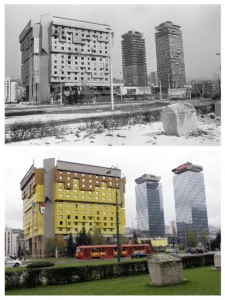
In the composite images captured by AP Photo/Hidajet Delic, we witness the transformation of Sarajevo’s Holiday Inn hotel and Unis towers. The top image depicts the aftermath of the devastating Bosnian Serb shelling in 1992, showcasing the damage inflicted on the structures situated on the notorious street dubbed “Sniper’s Alley.” Conversely, the bottom image, taken on November 17, 2005, portrays the remarkable restoration efforts that have revitalized these buildings, signifying resilience and hope amid the scars of conflict.
Conversely, hotels have also provided temporary havens for refugees and internally displaced individuals fleeing conflict zones. Equipped with essential amenities like generators, water tanks, and food stores, these structures have often served as vital nodes in broader infrastructure supporting persecuted and displaced populations.
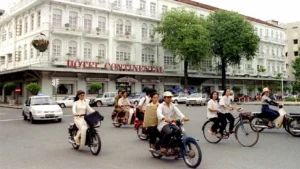
In the era of the First Indochina War, the Hotel Continental in Saigon, now known as Ho Chi Minh City, served as a bustling hub for journalists and politicians. Renamed as the Continental Palace during the Vietnam War, it became home to prominent bureaus of Newsweek and Time magazines. Notably, this historic establishment finds mention in Graham Greene’s acclaimed novel, The Quiet American/Reuters.
In response to the COVID-19 crisis, hotels have once again demonstrated their adaptability, offering self-contained isolation units for quarantine purposes. With international travel restrictions that were put in place, some hotels introduced “self-isolation” packages, ensuring minimal interaction between guests and staff. Moreover, hotels were repurposed as enforced quarantine spaces for returning travelers in various countries, contributing to global efforts to curb the virus’s spread.
 The Plaza Hotel, situated in Manhattan, New York, has undergone a temporary transformation into a field hospital catering to non-critical patients, captured by photographer Drew Angerer/Getty Images/AFP.
The Plaza Hotel, situated in Manhattan, New York, has undergone a temporary transformation into a field hospital catering to non-critical patients, captured by photographer Drew Angerer/Getty Images/AFP.
Beyond quarantine measures, hotels have also provided crucial support to healthcare systems under strain. Some have been converted into temporary field hospitals to accommodate non-critical patients, while others have offered complimentary accommodation to healthcare workers, easing the burden on frontline staff.
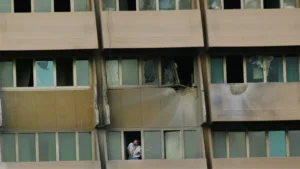
A man peers out from his hotel room following a rocket attack on the Al Rasheed Hotel in Baghdad on October 26, 2003. This hotel served as lodging for senior US military and civilian officials during that time. It gained notoriety during the first Gulf War when CNN broadcasted its news reports from within its walls. Post-war, a tile mosaic featuring US President George H.W. Bush was installed in the lobby, a gesture symbolizing the triumph of US forces. However, in the aftermath of the 2003 US invasion, American soldiers dismantled the mosaic, and the hotel was repurposed into a military base, captured by photographer Paula Bronstein/Getty Images.
Additionally, hotels were enlisted to protect vulnerable populations from the pandemic’s impact. In partnerships with governments and NGOs, hotels have offered shelter to the homeless, domestic violence victims, and rough sleepers, highlighting their role in fostering community resilience during times of crisis.
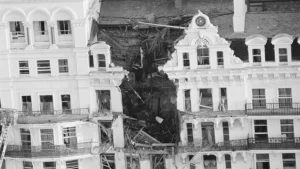
Five individuals lost their lives in an IRA bomb blast that occurred within the Grand Hotel in Brighton on October 12, 1984. This tragic incident took place during the annual conference of Margaret Thatcher’s Conservative Party, which was being held at the hotel, captured by photographer John Minihan/Express/Getty Images.
This adaptation underscores the evolving nature of the hotel industry, transcending its traditional association with luxury and wealth. While hotels have returned to their familiar roles as hubs of leisure and business, their pivotal role in crisis response serves as a reminder of their enduring importance in shaping the fabric of society. In times of adversity, the hospitality provided by hotels remains a cornerstone of communal resilience, embodying the interconnectedness of our shared human experience.


Leave a Reply